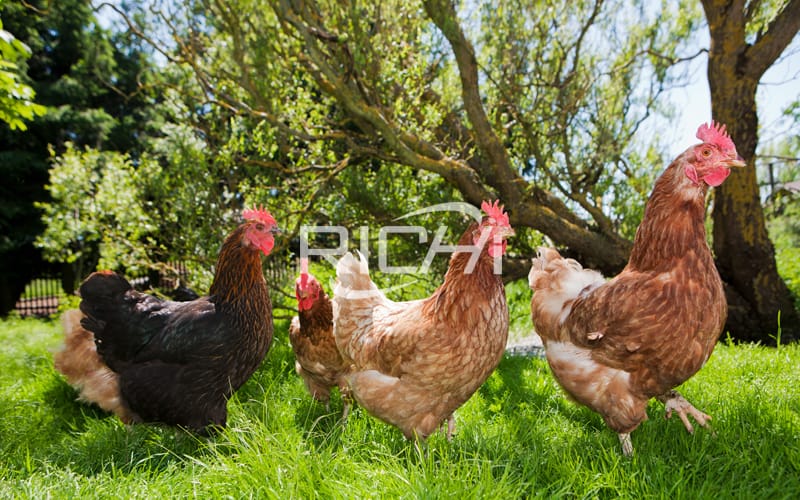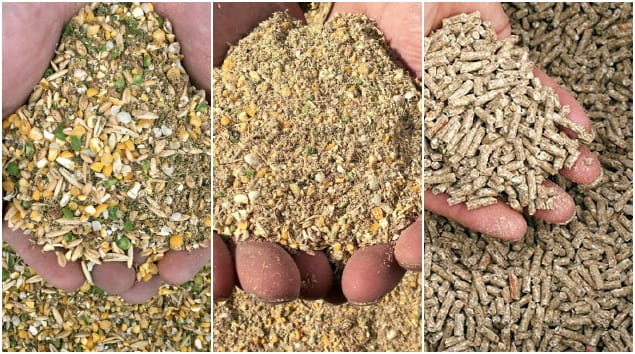
1. Direct waste in chicken farms
(1) Start meal
Put the newspaper or plastic sheet on the pad and spread the feed so that the chicks can eat freely. During the feeding process, the chicks are likely to pick up the feed on the ground or mix with the feces to cause waste; some newspapers are trampled on, and the feed leaks onto the litter, causing waste.
(2) Weight
About 2/3 of the feed consumed by chickens is used to maintain their own physiological needs. The larger the weight of the chicken, the more feed it consumes. If young chickens are not restricted in feeding, not only the feed is wasted, but the chicken body is too fat, which affects egg production.
(3) When the trough and the water trough are raised on the floor, if the trough is placed too low, the feed will be pulled out of the pan when the chicken eats, causing waste. The trough is damaged or unreasonable, and the trough is deformed or broken, resulting in waste of feed.
(4) Feeding too much feed at one time is the main cause of feed waste. The test statistics show that when the feed is added to 2/3 of the trough, 12% of the feed is wasted, when it is added to 1/2, the feed is wasted 5%, and when it is added to 1/3, the feed is wasted about 2%. Spilling of feed during manual feeding is more common in manual feeding chicken farms, and is mostly ignored by breeders.
(5) Rats and black rats and birds steal feed, which not only causes feed waste, but also contaminates feed, and can spread diseases.
2. Indirect waste in chicken farms
(1) Feed formula and nutrition
Unreasonable chicken feed making formula causes nutritional imbalance, resulting in the loss of relatively excess nutrients, or waste due to the ratio exceeding the nutritional standard. If the nutrition is not comprehensive, it will inevitably increase the feed intake to make up for the lack of a certain nutrient substance, which will result in waste of feed.
(2) Premix and raw materials
Some businesses adulterate in feed for higher profits, making the feed nutrition substandard. Improper storage of feed or too long time reduces or destroys the effectiveness of some vitamins. Antagonism of antibiotics and vitamins in feed leads to a lack of certain vitamins.
(3) Ambient temperature
The environment temperature is too cold or too hot, it will affect the chicken's feed intake, and the chicken flock's egg production rate and chicken feed conversion rate will be affected. The most suitable temperature for the chicken flock's living environment is 15~25℃. At this time, the feed returns are the highest, and the egg production and weight gain effects are the best. If the temperature is as high as 27°C, the flock's drinking water will increase and the appetite will decrease; if the temperature is lower than 10°C, the chicken body will consume additional feed to maintain body temperature.
(4) Illumination system
A reasonable light system can not only ensure the supply of nutrients, but also increase the feed conversion rate, thereby reducing feed waste. If the illumination time is too long and the intensity is too high, the consumption of feed will increase, but the performance of growth and egg production will decrease, and the utilization rate of feed will decrease.
(5) Chicken feed consumption increases due to constant beaks, unreasonable beak cuts, or failure to cut beaks in a timely manner. Experiments have proved that chickens with timely beak cut can save about 3% of feed consumption compared with chickens without beak cut.
(6) Diseases: Parasitic diseases and chronic wasting diseases lead to high feed input and low production (weight gain and egg production).

3. Preventive measures in chicken farms
(1) It is best to use special feeder trays for chicks. The size is determined according to the density. Feeding can be added frequently and fed less frequently to reduce waste. After one feed is finished and the stock is cleared, the remaining feed is concentrated to the pigs.
(2) Do a good job in the design, fixation and inspection of the trough. The feeding bucket for flat rearing should be hung up parallel to the back of the chicken. Large chickens can be 1 to 2 cm higher than the back of the chicken, so that the feed in the bucket Not easy to be picked out. The amount of feed for caged chickens should not be too much, generally 1/3 of the feeding trough is enough, and the feed is evened once every 1 to 24 hours. Evenly mix the remaining feed in the feeding trough with a spatula, which can save feed and stimulate the appetite of chickens. The feed trough is generally 1 to 2 cm higher than the chicken back, and should be installed on a firm shelf to prevent it from turning over. Breeders should pay attention to whether the trough is damaged when adding feed, and repair it in time.
(3) Timely weed out chickens with low yield, sickness, weakness, and serious habituation. It is necessary to prevent cold and heat preservation in winter, and to prevent heatstroke and reduce temperature in summer, and strive to control the most suitable house temperature and improve the feed conversion rate.
(4) Design a scientific and reasonable chicken feed formula to meet the chicken's needs for energy, protein, calcium and phosphorus, and increase the egg-to-feed ratio. At the same time, it is necessary to choose good quality chicken feed premix and chicken feed ingredients.
(5) The feed should be added appropriately, and the amount of feed should be gradually increased with the increase of the egg production rate. It is best to make the maximum consumption of chickens reach the peak egg production at the same time. Sufficient sand should be fed in time to improve the digestibility of chickens.
(6) Choose good varieties.
(7) Do a good job of killing rodents and birds, preventing diseases and disinfecting, not only can reduce feed waste, but also help prevent disease epidemics.
(8) To store the feed correctly, put the feed in a bag and place it on a wooden rack or raft 20 cm above the ground in the room to ensure good ventilation, rain leakage, and moisture proof. The room should be clean, dry, and relative humidity. Not higher than 60%, anti-mildew agent can also be added to prevent feed mildew.
【More info about chicken feed making】
Maintenance for several important equipments in 1-20tph chicken feed pellet production line
Best Quality 1-2 TPH Small Capacity Poultry Chicken Feed Mill Equipment and Production Process
How to prepare commercial pellet feeds with 1-70t/h broiler chicken feed production line with ce?
Layout design of 1-2t/h poultry pelllet making plant for chicken feed
Poultry chicken feed grinder for poultry chicken feed pellet making plant
10t/h chicken feed pelleting machine line for poultry
Cylinder Pulse Filter For 10T/H Chicken Feed Making Plant
What makes your 10t/h chicken feed mill equipment output gradually decline?
Effect of chicken feed making line processing technology on the safety of chicken feed
Analysis and Treatment Method of Blockage of Your 10T/H Chicken Feed Pellet Making Machine


